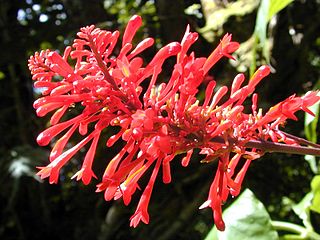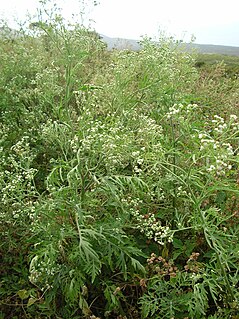
Acanthaceae is a family of dicotyledonous flowering plants containing almost 250 genera and about 2500 species. Most are tropical herbs, shrubs, or twining vines; some are epiphytes. Only a few species are distributed in temperate regions. The four main centres of distribution are Indonesia and Malaysia, Africa, Brazil, and Central America. Representatives of the family can be found in nearly every habitat, including dense or open forests, scrublands, wet fields and valleys, sea coast and marine areas, swamps, and mangrove forests.
Cross-cultural studies, sometimes called holocultural studies or comparative studies, is a specialization in anthropology and sister sciences that uses field data from many societies to examine the scope of human behavior and test hypotheses about human behavior and culture.

Ageratum is a genus of 40 to 60 tropical and warm temperate flowering annuals and perennials from the family Asteraceae, tribe Eupatorieae. Most species are native to Central America and Mexico but four are native to the United States.
Enriquebeltrania is a plant genus in the family Euphorbiaceae, first described in 1957. It was initially given the name Beltrania, but this turned out to be an illegitimate homonym. In other words, someone else had already applied the name to a different plant, so this one had to be renamed. The genus is native to western and southern Mexico.
- Enriquebeltrania crenatifolia(Miranda) Rzed. 1979 - Campeche, Quintana Roo, Yucatán
- Enriquebeltrania disjunctaDe-Nova & Sosa 2006 - Jalisco, Sinaloa

Parthenium is a genus of North American shrubs in the sunflower tribe within the daisy family.
Otoba is a genus of trees in family Myristicaceae that ranges from Nicaragua to Bolivia.

Heterotheca sessiliflora is a species of flowering plant in the daisy family known by the common name sessileflower false goldenaster. It is native to California, Sonora, and Baja California.

Victoria Louise "Pixie" Lott is an English singer and songwriter. Her debut album, Turn It Up, released in September 2009, reached number six on the UK Albums Chart and sold over 1.5 million copies. It also spawned six consecutive top twenty singles on the UK Singles Chart, including two #1 singles, "Mama Do " and "Boys and Girls". Her second album, Young Foolish Happy (2011), spawned the #1 hit "All About Tonight", as well as the top ten singles "What Do You Take Me For?" and "Kiss the Stars". Lott's self-titled third studio album, released in 2014, had the lead single "Nasty", which peaked at number nine on the UK Singles Chart, making it her sixth Top 10 single in the United Kingdom.

Microspermum is a genus of Mexican flowering plants in the boneset tribe within the sunflower family.

Rumfordia is a genus of Mesoamerican plants in the blackfoot tribe within the daisy family.
The Lott Carey Foreign Mission Convention was a movement in the 1890s by African-American Baptists of the National Baptist Convention, USA, Inc. who wanted to see more missions to Africa. The group eventually separated from the 'Mother Church' in 1897 due to disputes concerning the mission board. They chose to have greater cooperation with the white-dominated Southern Baptist Convention.
The San Antonio and Aransas Pass Railway first began operation in the U.S. state of Texas in 1886. It was developed by Uriah Lott and businessmen of San Antonio as a direct route from the city to Aransas Bay on the Texas Gulf coast. It was eventually absorbed in the 20th century by Southern Pacific.
Bonetiella is a monotypic genus of shrubs in the subfamily Anacardioideae of the cashew and sumac family Anacardiaceae. It contains the single species Bonetiella anomala, which is endemic to northern and central Mexico.
Wimmeranthus is a genus of flowering plants belonging to the family Campanulaceae.
Velascoa is a genus of flowering plants belonging to the family Crossosomataceae.
Calanticaria is a genus of flowering plants belonging to the family Asteraceae.
Ibervillea is a genus of flowering plants belonging to the family Cucurbitaceae.
Mirandea is a genus of flowering plants belonging to the family Acanthaceae.
Geniostemon is a genus of flowering plants belonging to the family Gentianaceae.






